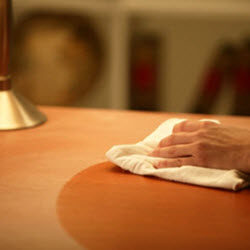 6 Tips to Manage Dust in the Home
6 Tips to Manage Dust in the Home
Reduce Dust In Your Home
Small dust, larger than 10 microns, makes up more than 90 percent of the weight of common household dust. This has been studied by scientists. Really small dust, less than 10 microns – which is essentially invisible to humans – doesn’t weigh much. However, when the small dust and the really small dust are added together the combined total make up 99 percent of all dust particles in your home.
No one wants a dusty home. Here are six tips to reduce dust in your home.
Here is a surprising point to consider. More than 90 percent of household dust comes from people and fabric. We all shed tiny flakes of skin that are barely visible. The fabrics in our homes (cloths and bedding and curtains for example) also shed small fibers. These items become the dust on our homes.
This dust settles and needs to be wiped up (not just moved around).
Therefore, for practical purposes, you cannot prevent the dust from entering your home. You need to remove it. Dust bothers us. The gray fluff that you see piled up in corners, on bookshelves, and under the couch needs to be removed.
What can you do to reduce the amount of dust in your home?
Organize your Closets
Closets are a dust haven. They are full of items with tiny fibers such as clothes, towels and bedding. Every time you open the door, you bring the dust that is inside the closet into the room.
You can’t prevent fabrics from shedding fibers, but you can make closets easier to keep clean. This will vastly cut down on dust. You can also box or bag items. Clear plastic containers are best—they lock fibers in and dust out and let you see what’s inside. When you dust, they’re easy to pull off the shelves and wipe clean.
If you have a collection of winter items know that while you may only wear them for part of the year that they shed fibers year-round. Use garment bags. This helps to keep the dust they cause from entering your room and keeps the clothes themselves from becoming coated with dust.
Keep closet floors clear. If the floor is cluttered, chances are you’ll just bypass it while vacuuming, and dust bunnies will start to form.
Clean the Air While You Clean
All vacuums whip up dust with their “agitator” (the cylindrical brush that sweeps the carpet) and with the blowing exhaust stream. That dust eventually settles on the surfaces you’ve just cleaned.
Vacuum twice a week. Use a high quality vacuum equipped with a HEPA (high-efficiency particulate air) filter. A HEPA filter will ensure that you’re sucking up as much dust as possible. All vacuums used by A Clean Vision are equipped with HEPA filters.
Even if A Clean Vision cleans your home only once or twice a month the level of dust will be significantly reduced. You will notice a difference right away.
If you have a forced air heating and cooling system you can also turn on the fan which can help to filter the dust out of the air that has been stirred up by vacuuming.
Leave the fan on for about 15 minutes after the cleaning has been completed.
Use the Proper Cleaning Supplies
The key activity is to capture dust. You don’t want to just spread it around. Don’t use feather dusters or dry rags. A damp cloth or disposable cloths that attract and hold dust with an electrostatic charge work much better. Cloths that attract dust with oils or waxes also work well but can leave residue on furniture.
Sometimes you may need to vacuum a surface if they are hard to dust with a cloth, such as rough surfaces and intricate woodwork. Again, make sure your vacuum has a HEPA filter.
Use A High Powered Vacuum with an Agitator. Strong suction helps but to do the best job on carpets a vacuum with a powerful agitator is needed. A Clean Vision will always use an agitator to help pick up dust and debris from carpets.
For wood, tile or vinyl flooring, the best choice is to use a vacuum without the agitator turned on.
To reduce dust in your home vacuuming matters.
Give Carpets and Cushions a Good Beating
Carpets are a huge dust reservoir, since all its fibers absorb dust like a giant sponge and sends it airborne every time you take a step. Vacuuming at least once week—sometimes more for allergy sufferers—can help, but taking carpets outside for a good beating is often overlooked. Drape them over a fence or clothesline and beat them with a broom or tennis racket.
Give your cushions the same treatment. Upholstery fabric not only sheds its own fibers but also absorbs dust that settles on it, so you raise puffs of dust every time you sit down. Beat cushions in the backyard or use slipcovers and give them a good shake. If you want to eliminate upholstery dust, buy leather furniture.
Mop the Floors Often
Going over your wood and tile floors with a wet mop is a great way to collect the dust you missed while sweeping. If you mop frequently, you’ll be able to get the dust under control. Letting it go too long will make it a lot more difficult to clean up all the dust and dirt, and you may need to do some scrubbing.
Spot Filter
Get an air purifier if there is a room or area that is particularly dusty. This approach can also be helpful for the room of someone that is extra sensitive to dust.
These machines clean the air by trapping dust particles. The can also be great for high-dust households or families with dust allergies. Air purifiers only clean the air in the room they’re in, so consider getting one for each bedroom and the living room.
An effective air cleaner can remove large and small particles from the air. Within that space, it can relieve allergy or asthma symptoms and even reduce smoke and cooking odors.
Reduce Dust In Your Home
If you want A Clean Vision to help you with your home cleaning efforts, then give us a call at 802-295-6065. We have been helping home owners of the Upper Valley with all sorts of home cleaning tasks.

